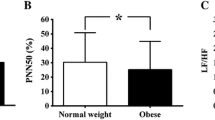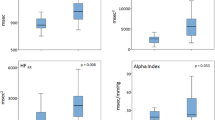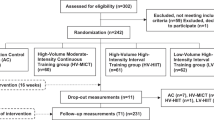Abstract
Purpose
This feasibility study aimed to analyze the effects of a multidisciplinary (e.g., psychological, nutritional and water-based exercise interventions) obesity treatment program on resting heart rate variability (rHRV) indices according to the degree of excess body mass (overweight vs obesity) in adolescents. Additionally, we tested the association between changes in rHRV indices with changes in body composition and cardiorespiratory fitness.
Methods
Twenty-five adolescents completed the study, 11 from the overweight group (OWG) and 14 from the obese group (OBG) classified according to body mass index. Anthropometric measures, autonomic cardiac function (measured by rate-to-rate interval analyses), lean mass and body fat, and cardiorespiratory fitness were assessed prior to and after the 16-week intervention period.
Results
Both groups increased their parasympathetic indices (e.g., standard deviation 1) [OWG: Δ = 8.5 (1.7–15.3) ms; magnitude of change: “likely”; OBG: Δ = 11.4 (4.3–18.4) ms; “very likely”] and cardiorespiratory fitness [OWG: Δ = 2.0 (1.1–2.8) mL/kg/min; “likely”; OBG: Δ = 2.4 (1.5–3.3) mL/kg/min; “Almost certain”] with a slightly greater magnitude of change for the OBG. The OWG showed greater changes in body composition [e.g., body fat: Δ = −3.2 (–4.6 to −1.8) kg “Very likely”] when compared to the OBG [Δ = −2.8 (−4.4 to −1.3) kg “Possible”]. Inverse and large correlations were noted for changes in body fat markers (%) and changes in parasympathetic indices of rHRV (%) (i.e., rMSSD and SD1).
Conclusions
These results provide evidence that a multidisciplinary program improves parasympathetic indices, body composition, and cardiorespiratory fitness independent of the degree of excess body mass.

Similar content being viewed by others
Abbreviations
- BMI:
-
Body mass index
- HF:
-
High frequency
- HRrest:
-
Resting heart rate
- OBG:
-
Obese adolescent group
- OWG:
-
Overweight adolescents group
- rHRV:
-
Resting heart rate variability
- rMSSD:
-
Square root of the mean of the squares of successive R–R interval differences
- SD1:
-
Standard deviation 1 of instantaneous beat-to-beat R–R interval variability measured from Poincare plots
- VO2max :
-
Maximal oxygen consumption
References
(1996) Task Force of the European Society of Cardiology and the North American Society of Pacing and Electrophysiology. Heart rate variability: standards of measurement, physiological interpretation, and clinical use. Eur Heart J 17:354–381
Eckberg DL, Drabinsky M, Braunwald E (1971) Defective cardiac parasympathetic control in patients with heart disease. N Engl J Med 285:877–883
Zhou Y, Xie G, Wang J, Yang S (2012) Cardiovascular risk factors significantly correlate with autonomic nervous system activity in children. Can J Cardiol 28(4):477–482
Kaufman CL, Kaiser DR, Steinberger J, Kelly AS, Dengel DR (2007) Relationships of cardiac autonomic function with metabolic abnormalities in childhood obesity. Obesity 15(5):1164–1171
Taşçılar ME, Yokuşoğlu M, Boyraz M, Baysan O, Köz C, Dündaröz R (2011) Cardiac autonomic functions in obese children. J Clin Res Pediatr Endocrinol 3(2):60–64
da Silva DF, Bianchini JA, Antonini VD, Hermoso DA, Lopera CA, Pagan BG, McNeil J, Nardo Junior N (2014) Parasympathetic cardiac activity is associated with cardiorespiratory fitness in overweight and obese adolescents. Pediatr Cardiol 35:684–690
da Silva DF, Bianchini JA, Lopera CA, Capelato DA, Hintze LJ, Nardo CC, Ferraro ZM, Nardo Junior N (2015) Impact of readiness to change behavior on the effects of a multidisciplinary intervention in obese Brazilian children and adolescents. Appetite 87:229–235
Dâmaso AR, da Silveira Campos RM, Caranti DA, de Piano A, Fisberg M, Foschini D, de Lima Sanches P, Tock L, Lederman HM, Tufik S, de Mello MT (2014) Aerobic plus resistance training was more effective in improving the visceral adiposity, metabolic profile and inflammatory markers than aerobic training in obese adolescents. J Sports Sci 32(15):1435–1445
Masquio DC, de Piano-Ganen A, Oyama LM, Campos RM, Santamarina AB, de Souza GI, Gomes AD, Moreira RG, Corgosinho FC, do Nascimento CM, Tock L, Tufik S, de Mello MT, Dâmaso AR (2016) The role of free fatty acids in the inflammatory and cardiometabolic profile in adolescents with metabolic syndrome engaged in interdisciplinary therapy. J Nutr Biochem 33:136–144
Lopera CA, da Silva DF, Bianchini JA, Locateli JC, Moreira AC, Dada RP, Thivel D, Junior Nardo N (2016) Effect of water- versus land-based exercise training as a component of a multidisciplinary intervention program for overweight and obese adolescents. Physiol Behav 165:365–373
Tian Y, Huang C, He Z, Hong P, Zhao J (2015) Autonomic function responses to training: correlation with body composition changes. Physiol Behav 151:308–313
Prado DM, Silva AG, Trombetta IC, Ribeiro MM, Guazzelli IC, Matos LN, Santos MS, Nicolau CM, Negrão CE, Villares SM (2010) Exercise training associated with diet improves heart rate recovery and cardiac autonomic nervous system activity in obese children. Int J Sports Med 31:860–865
Mazurak N, Sauer H, Weimer K, Dammann D, Zipfel S, Horing B, Muth ER, Teufel M, Enck P, Mack I (2016) Effect of a weight reduction program on baseline and stress-induced heart rate variability in children and obesity. Obesity 24(2):439–445
Farinatti P, Neto SR, Dias I, Cunha FA, Bouskela E, Kraemer-Aguiar LG (2016) Short-term resistance training attenuates cardiac autonomic dysfunction in obese adolescents. Pediatr Exerc Sci 28(3):374–380
Ng M, Fleming T, Robinson M, Thomson B, Graetz N, Margono C, Mullany EC, Biryukov S, Abbafati C, Abera SF, Abraham JP, Abu-Rmeileh NM, Achoki T, AlBuhairan FS, Alemu ZA, Alfonso R, Ali MK, Ali R, Guzman NA, Ammar W, Anwari P, Banerjee A, Barquera S, Basu S, Bennett DA, Bhutta Z, Blore J, Cabral N, Nonato IC, Chang JC, Chowdhury R, Courville KJ, Criqui MH, Cundiff DK, Dabhadkar KC, Dandona L, Davis A, Dayama A, Dharmaratne SD, Ding EL, Durrani AM, Esteghamati A, Farzadfar F, Fay DF, Feigin VL, Flaxman A, Forouzanfar MH, Goto A, Green MA, Gupta R, Hafezi-Nejad N, Hankey GJ, Harewood HC, Havmoeller R, Hay S, Hernandez L, Husseini A, Idrisov BT, Ikeda N, Islami F, Jahangir E, Jassal SK, Jee SH, Jeffreys M, Jonas JB, Kabagambe EK, Khalifa SE, Kengne AP, Khader YS, Khang YH, Kim D, Kimokoti RW, Kinge JM, Kokubo Y, Kosen S, Kwan G, Lai T, Leinsalu M, Li Y, Liang X, Liu S, Logroscino G, Lotufo PA, Lu Y, Ma J, Mainoo NK, Mensah GA, Merriman TR, Mokdad AH, Moschandreas J, Naghavi M, Naheed A, Nand D, Narayan KM, Nelson EL, Neuhouser ML, Nisar MI, Ohkubo T, Oti SO, Pedroza A, Prabhakaran D, Roy N, Sampson U, Seo H, Sepanlou SG, Shibuya K, Shiri R, Shiue I, Singh GM, Singh JA, Skirbekk V, Stapelberg NJ, Sturua L, Sykes BL, Tobias M, Tran BX, Trasande L, Toyoshima H, van de Vijver S, Vasankari TJ, Veerman JL, Velasquez-Melendez G, Vlassov VV, Vollset SE, Vos T, Wang C, Wang X, Weiderpass E, Werdecker A, Wright JL, Yang YC, Yatsuya H, Yoon J, Yoon SJ, Zhao Y, Zhou M, Zhu S, Lopez AD, Murray CJ, Gakidou E (2014) Global, regional, and national prevalence of overweight and obesity in children and adults during 1980–2013: a systematic analysis for the Global Burden of Disease Study 2013. Lancet 384(9945):766–781
Antonini VD, da Silva DF, Bianchini JA, Lopera CA, Moreira AC, Locateli JC, Nardo Júnior N (2014) Physical, clinical, and psychosocial parameters of adolescents with different degrees of excess weight. Rev Paul Pediatr 32(4):342–350
Rank M, Siegrist M, Wilks DC, Langhof H, Wolfarth B, Haller B, Koenig W, Halle M (2013) The cardio-metabolic risk of moderate and severe obesity in children and adolescents. J Pediatr 163(1):137–142
Rossi RC, Vanderlei LC, Gonçalves AC, Vanderlei FM, Bernardo AF, Yamada KM, da Silva NT, de Abreu LC (2015) Impact of obesity on autonomic modulation, heart rate and blood pressure in obese young people. Auton Neurosci 193:138–141
Patsopoulos NA (2011) A pragmatic view on pragmatic trials. Dialogues Clin Neurosci 13(2):217–224
Sox HC, Lewis RJ (2016) Pragmatic trials: practical answers to “real world” questions. JAMA 316(11):1205–1206
Cole TJ, Lobstein T (2012) Extended international (IOTF) body mass index cut-offs for thinness, overweight and obesity. Pediatr Obes 7(4):284–294
Cooper Z, Fairburn CG, Hawker DM (2003) Cognitive-behavioral treatment of obesity. The Guildford Press, New York
Lohman T, Roche A, Martorel R (1988) Anthropometric standardization manual. Human Kinetics, Champaign
Heyward VH (2001) ASEP methods recommendation: body composition assessment. J Exerc Physiol 4:1–12
Léger LA, Mercier D, Gadoury C, Lambert J (1988) The multistage 20 meter shuttle run test for aerobic fitness. J Sports Sci 6(2):93–101
Williams DP, Jarczok MN, Ellis RJ, Hillecke TK, Thayer JF, Koenig J (2016) Two-week test–retest reliability of the Polar® RS800CX™ to record heart rate variability. Clin Physiol Funct Imaging. doi:10.1111/cpf.12321
Haddad HA, Laursen PB, Chollet D, Ahmaidi S, Buchheit M (2011) Reliability of resting and postexercise heart rate measures. Int J Sports Med 32(8):598–605
Bellenger CR, Fuller JT, Thomson RL, Davison K, Robertson EY, Buckley JD (2016) Monitoring athletic training status through autonomic heart rate regulation: a systematic review and meta-analysis. Sports Med 46(10):1461–1486
Buchheit M (2014) Monitoring training status with HR measures: do all the roads lead to Rome? Front Physiol 5:1–19
Vickers AJ, Altman DG (2001) Statistics notes: analyzing controlled trials with baseline and follow up measurements. BMJ 323:1123–1124
Hopkins WG, Marshall SW, Batterham AM, Hanin J (2009) Progressive statistics for studies in sports medicine and exercise science. Med Sci Sports Exerc 41(1):3–13
da Silva DF, Verri SM, Nakamura FY, Machado FA (2014) Longitudinal changes in cardiac autonomic function and aerobic fitness indices in endurance runners: a case study with a high-level team. Eur J Sport Sci 14(5):443–451
Matsuo AR, da Silva DF, Bianchini JAA, Hintze LJ, Antonini VDS, Lopera CA, Hernandes F, McNeil J, Nardo Junior N (2016) Differences between obese and severely obese adolescents in relation to the effects of a multidisciplinary intervention on hypertriglyceridemic waist phenotype. JEP 19(2):68–75
Billman GE (2009) Cardiac autonomic neural remodeling and susceptibility to sudden cardiac death: effect of endurance exercise training. Am J Physiol Heart Circ Physiol 297:H1171–H1193
Myers J, McAuley P, Lavie CJ, Despres JP, Arena R, Kokkinos P (2015) Physical activity and cardiorespiratory fitness as major markers of cardiovascular risk: their independent and interwoven importance to health status. Prog Cardivasc Dis 57(4):306–314
Balagopal PB, de Ferranti SD, Cook S, Daniels SR, Gidding SS, Hayman LL, McCrindle BW, Mietus-Snyder ML, Steinberger J, American Heart Association Committee on Atherosclerosis Hypertension and Obesity in Youth of the Council on Cardiovascular Disease in the Young, Council on Nutrition, Physical Activity and Metabolism, Council on Epidemiology and Prevention (2011) Nontraditional risk factors and biomarkers for cardiovascular disease: mechanistic, research, and clinical considerations for youth: a scientific statement from the American Heart Association. Circulation 123(23):2749–2769
de Mello MT, de Piano A, Carnier J, Sanches Pde L, Corrêa FA, Tock L, Ernandes RM, Tufik S, Dâmaso AR (2011) Long-term effects of aerobic plus resistance training on the metabolic syndrome and adiponectinemia in obese adolescents. J Clin Hypertens (Greenwich) 13(5):343–350
Farah BQ, Barros MVG, Balagopal B, Ritti-Dias RM (2014) Heart rate variability and cardiovascular risk factors in adolescent boys. J Pediatr 165(5):945–950
Gutin B, Barbeau P, Litaker MS, Ferguson M, Owens S (2000) Heart rate variability in obese children: relations to total body and visceral adiposity, and changes with physical training and detraining. Obes Res 8(1):12–19
Sala R, Malacarne M, Solaro N, Pagani M, Lucini D (2017) A composite autonomic index as unitary metric for heart rate variability: a proof of concept. Eur J Clin Invest 47:241–249
Michels N, Clays E, De Buyzere M, Huybrechts I, Marild S, Vanaelst B, De Henauw S, Sioen I (2013) Determinants and reference values of short-term heart rate variability in children. Eur J Appl Physiol 113(6):1477–1488
Gutin B, Howe C, Johnson MH, Humphries MC, Snieder H, Barbeau P (2005) Heart rate variability in adolescents: relations to physical activity, fitness, and adiposity. Med Sci Sports Exerc 37(11):1856–1863
Oliveira RS, Barker AR, Wilkinson KM, Abbott RA, Williams CA (2017) Is cardiac autonomic function associated with cardiorespiratory fitness and physical activity in children and adolescents? A systematic review of cross-sectional studies. Int J Cardiol pii S0167–5273(16):33182–33185
Chen SR, Chiu HW, Lee YJ, Sheen TC, Jeng C (2012) Impact of pubertal development and physical activity on heart rate variability in overweight and obese children in Taiwan. J Sch Nurs 28(4):284–290
Greene NP, Lambert BS, Greene ES, Carbuhn AF, Green JS, Crouse SF (2009) Comparative efficacy of water and land treadmill training for overweight or obese adults. Med Sci Sports Exerc 41(9):1808–1815
Sheldahl LM (1986) Special ergometric techniques and weight reduction. Med Sci Sports Exerc 18(1):25–30
Ricco RC, Ricco RG, Almeida CAN, Ramos APP (2010) Comparative study of risk factors among children and adolescents with an anthropometric diagnosis of overweight or obesity. Rev Paul Pediatr 28(4):320–325
Acknowledgements
The authors thank the members of the Multiprofessional Nucleus of Obesity Treatment program for their contribution to data collection and intervention development; they also thank the Araucaria Foundation (Agreement 179/10, protocol 19213) and Capes (501100002322) for financial support.
Author information
Authors and Affiliations
Corresponding author
Ethics declarations
Funding
This study was funded by Araucaria Foundation (agreement 179/10, protocol 19213).
Conflict of interest
The authors declare that they have no conflict of interest.
Ethical standard
This study was approved by the local Ethics Committee (protocol 463/2009). All procedures performed in studies involving human participants were in accordance with the ethical standards of the institutional and/or national research committee and with the 1964 Helsinki declaration and its later amendments or comparable ethical standards.
Informed consent
Informed consent was obtained from all individual participants included in the study as well as their guardians.
Rights and permissions
About this article
Cite this article
Locateli, J.C., da Silva, D.F., Bianchini, J.A.A. et al. Autonomic cardiac function, body composition and cardiorespiratory fitness changes in adolescents after a multidisciplinary obesity treatment program: a feasibility study. Sport Sci Health 14, 25–35 (2018). https://doi.org/10.1007/s11332-017-0396-z
Received:
Accepted:
Published:
Issue Date:
DOI: https://doi.org/10.1007/s11332-017-0396-z




